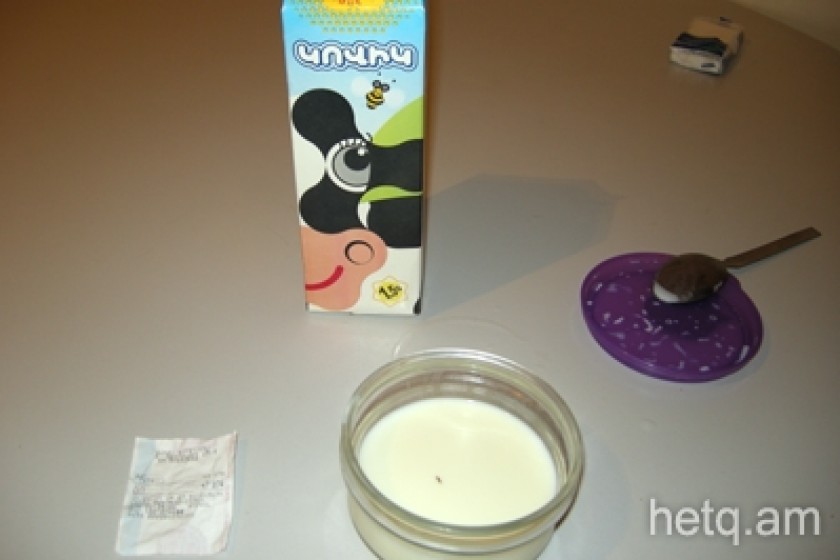
Mothers Ask - Are Those Worms in My Ashtarak Milk?
Gayaneh Ayvazyan, a Yerevan resident, found a worm in some Ashtarak milk she was giving her two year-old daughter. She says it’s not the first time finding a foreign object in the milk.
“And what do I find – a worm. I was surprised to say the least. How does a worm turn up in the milk,” Gayaneh rhetorically asks.
The young mother photographed the wormy milk and put the photo on her Facebook page. She asked friends what her options were.
 “Some suspected that maybe I had worms in the house or something. This was the type of worm you see in flour that goes stale. I poured the milk myself and no worms jumped into the glass, says Gayaneh.
“Some suspected that maybe I had worms in the house or something. This was the type of worm you see in flour that goes stale. I poured the milk myself and no worms jumped into the glass, says Gayaneh.
Inessa Vardanyan, Ashtarak’s brand manager also participated in the Facebook discussion.
She ruled out the possibility of tainted milk leaving the production facility and invited Gayaneh to the milk plant to see the conditions for herself.
Hetq also spoke with Inessa Vardanyan, promising to provide all encompassing answers to our questions if submitted in writing.
Six days have since passed and Ashtarak Milk hasn’t gotten back to us.
Gayaneh Ayvazyan isn’t the only who’s sounded the alarm over tainted “Kovik” milk produced by Ashtarak.
Rouzanna Sargsyan, a teacher, told us that in March she found three worms in some “Kovik” milk she was giving to her 11 month old child.
 “Naturally, I threw it out. I thought I couldn’t prove anything, I called up the Consumers’ Union and they said nothing could be done since I had discarded the evidence. I then wrote about the incident in Facebook, figuring the company would get wind of the problem and do some necessary testing. It seems that the company did nothing of the kind,” says Rouzanna.
“Naturally, I threw it out. I thought I couldn’t prove anything, I called up the Consumers’ Union and they said nothing could be done since I had discarded the evidence. I then wrote about the incident in Facebook, figuring the company would get wind of the problem and do some necessary testing. It seems that the company did nothing of the kind,” says Rouzanna.
By the way, the worms she describes resemble those found by Gayaneh.
Rouzanna theorizes that the worms might have been in the dried milk powder used by Ashtarak, even though they advertise “Kovik” as fresh milk.
Otherwise, she believes the worms are getting into the milk due to unsanitary conditions at the packaging plant.
The milk powder theory seems more plausible, especially given recent press reports that Ashtarak has been using powder additives.
At the time, the Ashtarak Milk director flatly denied such reports.
Armen Poghosyan, who heads the Consumers Association says how the worms are getting into the milk is beside the point.
“The fact that worms are showing up in the milk is a crime itself. It’s an issue for the Prosecutor’s Office and not just government food agencies. We are talking about this milk being fed to children. We must double our efforts to rule out such problems.
Hetq spoke to an employee at Ashtarak and he too denied that the company was using powder in “Kovik” milk.
He suggested that we bring samples of the milk to the company’s lab for testing, adding that the company would pay for independent testing of Gayaneh Ayvazyan’s milk sample.
Naturally, Hetq rejected the company’s offer.
We went to the Food Safety Service at the Ministry of Agriculture and requested that it test some “Kovik” milk to see if contained powder and, if so, could the worms have been in the powder.
The Food Safety Service told us that in Armenia such testing could only be performed by a company called Standard Dialog.
So we got in touch with Standard Dialog. An employee, who avoided giving her name, told us that her boss said that the company was backlogged with work right now and that they couldn’t help us.
Soon afterwards, we called and spoke with someone else at Standard Dialog. This staffer said we should try calling in a week or so and they would test the milk. This conversation took place on September 20.
Readers might remember that last year Ashtarak Milk had denied rumours that it was using milk powder to produce cheese.
Not taking the company at its word, the State Commission for Economic Competition did some testing of its own.
Results showed that that the cheese not only contained milk powder but also some non-diary elements, in particular baking soda, which is prohibited.
 Videos
Videos Photos
Photos
Comments (30)
Write a comment